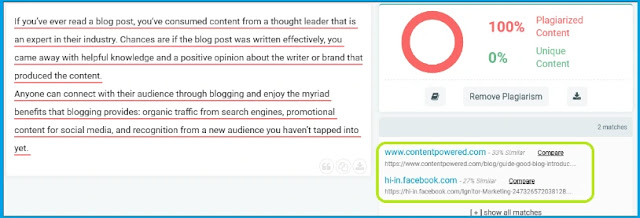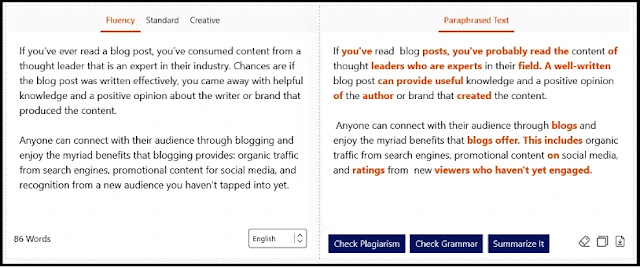Plagiarism-free content is ideal for blogs and websites. But how can a blogger generate plagiarism free content?
With the advancement of the internet over the past 2-3 decades, the overabundance of information also increased.
However, it also caused writers many opportunities to plagiarize content. Nowadays, plagiarism is a common problem for many bloggers—unintentional or intentional.
 |
| How to Generate Plagiarism Free Content Blogging Tips |
A website suggests that around 1.5 billion pages on the internet have plagiarized content. In other words, you can find plagiarized text on approximately 29% of the websites on the internet.
So, how do you write plagiarism-free content?
Moreover, what is an effective way of detecting and removing plagiarism? Let's dive in deeper and answer these questions.
What is Plagiarism-Free Content?
Plagiarism is the unethical practice of copying someone else's work or ideas and posting them as your own.
This includes things like quoting without giving credit, paraphrasing without citation, or copying and pasting without attribution.
Plagiarism-free content is content that is original and not copied from other sources. It is the primary requirement in any type of content that can be used for different purposes, such as:
Social media posts
And even entire marketing campaigns
In other words, the sort of content that has been written by the original author and no other person. The content should not be similar to another writer's work and definitely not copied from any other source.
Since plagiarism is a severe offense in academic and professional circles, it can undermine the writer's and employer's credibility.
Therefore, plagiarism-free content is absolutely original, and nothing about it is copied or taken from another source.
A few common traits of plagiarism-free content include:
Original titles and ideas
Unmatched intros and beginnings
Stats and fact-filled middle/body of the content
Unparalleled conclusions
Overall informative value
Original ideas throughout the content
These factors in blogging can help you identify original content quickly.
Why is Plagiarism Free Content Important?
Plagiarism is a big problem nowadays. Many article spinners and online article generators can provide you with plagiarized content.
And then there are the websites that pay people to write articles for them and never check if the content they get is plagiarized or not.
It's imperative to make sure that your content is plagiarism-free. It will help you rank better in search engines; it will help you gain more trust from your readers.
And it will provide an improved reading experience for your audience.
Few other common benefits of original content include:
Higher search engine ranks
Established authority
Increased credibility
Build trust with the audience
Build relations with other websites and blogs (For guest blogging)
Moreover, plagiarism-free content is important to avoid legal issues and help you establish a good reputation. It is important to note that plagiarism-free content does not only mean original content.
It means that the content is written in your own words, and you are not copying from other sources without giving credit to their original author.
While the similarities between ideas can be present, a common trait of plagiarism-free text is giving credit where it's due.
05 Effective Blogging Tips To Create Plagiarism-Free Content
To remove plagiarism, we have to find it first. And to find plagiarism, we need a dependable tool.
Then, removing that plagiarism becomes much easier. Therefore, here are our five tips to help you generate plagiarism-free content.
1. Find Plagiarism & Analyze The Percentage
The first step is to find plagiarism with the help of any online plagiarism checker and analyze the percentage of duplicate content.
We'll be copying text from another website to ensure that the tool detects it. Here's what it looks like once a plagiarism checker is ready to scan:
 |
| Find Plagiarism Content |
Now, Checker starts to scans your text.
This will roughly take five to ten seconds, and once done, you get to see the percentage of plagiarism in your text.
Remember, this is something you do not want to see in your text. As mentioned before, we deliberately copied content from another website to get this result. Let's move on to the next step.
2. Locate the Source & Note It Down
Before we rewrite the plagiarized section of our text, it's important to find the source of it. It will help us cite it as the original author (to avoid plagiarism effectively) and give us a little more credibility.
Therefore, scroll down a little more to find the link to the original text:
 |
| Check Source of Plagiarism text |
What you see marked in green is the link to the source(s). Therefore, we'll note it down to remove plagiarism by citing it later.
3. Use A Paraphraser To Rewrite Plagiarized Text
Now, we know there's plagiarism in our content. Let's rewrite it to remove plagiarism.
A blogger can remove duplication from content if they know how to paraphrase correctly.
Writers or web admins can rephrase online to produce unique and readable content for their audience, which ranks well according to search engine ranking standards.
Once the tool is ready, here's what it looks like
 |
| Rewrite Plagiarized Text Using Online Tool |
What you see marked in green are language and content tone selection. Make sure the language is the same as your content and that you pick the content tone that matches the rest of your text.
Once you proceed, the content starts to paraphrased at this point. However, it flashes by your screen, as it barely takes a few seconds to rewrite. Once done, here's what you see:
 |
| Check Rephrased Text |
The content marked in orange is the rephrased text. If you feel like it's not enough, you can always go back and paraphrase it again.
4. Cite The Source Properly
The next step is to cite properly. You don't have to get formal in a blog, but if you do, you can try MLA or APA citation styles. However, a simple backlink to the original website/author will suffice too. In other words, as long as you give credit to the original source.
5. Check For Plagiarism Again
The final step is to ensure that your content is original before you post it. Once you scan your content for plagiarism again, this is what you should see:
 |
| Use Tool to Rephrase Plagiarism Text |
As noticeable here, the content is now 100% unique, and there's no plagiarism in it anymore. This is ideal. On top of that, we cited the source, so we're also 100% of its originality.
Conclusion
There you have it, folks, the ways you can ensure the originality of your text. This process will help you make your blog content plagiarism-free and allow you to do so efficiently.
So, follow our tips, use the tools we mentioned, and you're good to go.
You may also like to read:

ConversionConversion EmoticonEmoticon